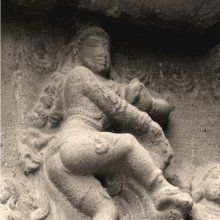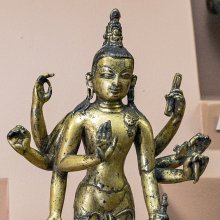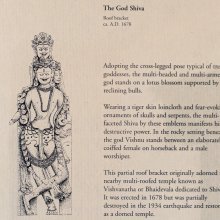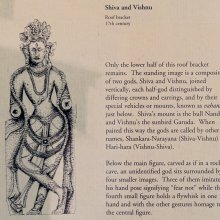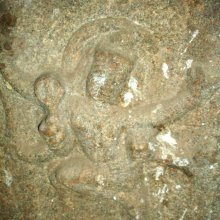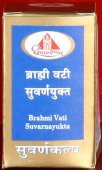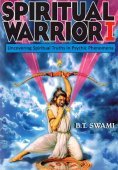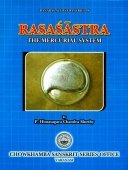Fear: 5 definitions
Introduction:
Fear means something in Hinduism, Sanskrit, Jainism, Prakrit, the history of ancient India, biology. If you want to know the exact meaning, history, etymology or English translation of this term then check out the descriptions on this page. Add your comment or reference to a book if you want to contribute to this summary article.
Images (photo gallery)
(+3 more images available)
In Hinduism
Natyashastra (theatrics and dramaturgy)
Source: Shodhganga: Elements of Art and Architecture in the Trtiyakhanda of the Visnudharmottarapurana (natya)1) Fear (expression) is associated with Prakampita: one of the “seven movements of the chest” (in Sanskrit Dramas), as conveyed through Āṅgikābhinaya: one of the four divisions of Abhinaya or “ways to convey or represent one’s emotion to others”, according to the Nāṭyaśāstra and the Viṣṇudharmottarapurāṇa, an ancient Sanskrit text which (being encyclopedic in nature) deals with a variety of cultural topics such as arts, architecture, music, grammar and astronomy.—The āṅgikābhinaya includes the histrionic representation of the limbs which is simply known as physical gestures. There are five kinds of chest movements accepted by the Viṣṇudharmottarapurāṇa as well as the Nāṭyaśāstra. At the time of laughing, weeping or showing fear, the chest is thrown up and it is called prakampita movement.
2) Fear (expression) is also associated with Apasṛta: one of the “five kinds of side-movements”.—There are five kinds of side movements accepted in the Viṣṇudharmottarapurāṇa. The apasṛta movement is taken to show fear whereas the Nāṭyaśāstra suggests it as the movement adopted in returning.
3) Walking in Fear is associated with Śīghra-gati: one of the various Gatis (“way of walking”).—Śīghragati or quick gait should be adopted in fear, terror, anger, joy, rapid and urgent actions, on hearing distasteful information, on seeing unbelievable things, searching of crime factors etc. In the Mṛcchakaṭika of Śudraka, the heroin Vasantasenā was moving speedily in terror as she was followed by some cunning persons like Vīṭa, Ceṭa and Śakāra and her gait was crossing over the speed of wind. This can be taken as a manifestation of śīghra-gati.

Natyashastra (नाट्यशास्त्र, nāṭyaśāstra) refers to both the ancient Indian tradition (shastra) of performing arts, (natya—theatrics, drama, dance, music), as well as the name of a Sanskrit work dealing with these subjects. It also teaches the rules for composing Dramatic plays (nataka), construction and performance of Theater, and Poetic works (kavya).
Ayurveda (science of life)
Source: International Research Journal of Ayurveda and Yoga: Role of Ayurveda in the Management of Manas Roga (Mental Disorders)Fear (Bhaya) refers to one of the negative conditions of modern society.—Mental Health (according to Ayurveda) is brought about essentially as a result of unwholesome interaction between the individual and this environment. Epidemiological studies report prevalence rates for psychiatric disorders varying from 9.5 to 370/1000 population in India. [...]. In today’s metaphysical society, human life has become speedy, mechanized, and less effective and more centred, which contribute to more production of [e.g., Bhaya (fear)].

Āyurveda (आयुर्वेद, ayurveda) is a branch of Indian science dealing with medicine, herbalism, taxology, anatomy, surgery, alchemy and related topics. Traditional practice of Āyurveda in ancient India dates back to at least the first millenium BC. Literature is commonly written in Sanskrit using various poetic metres.
In Jainism
General definition (in Jainism)
Source: academia.edu: Tessitori Collection IFear refers to one of the “thirteen difficulties”, according to the “Teraha kāṭhīyā-svādhyāya” by Jinaharṣa (dealing with the Ethics section of Jain Canonical literature), which is included in the collection of manuscripts at the ‘Vincenzo Joppi’ library, collected by Luigi Pio Tessitori during his visit to Rajasthan between 1914 and 1919.—The exposition of the ‘thirteen difficulties’ [e.g., fear (bhaya)] against which one should fight as they are hindrances to proper religious practice is a widespread topic in Jain literature in Gujarati.

Jainism is an Indian religion of Dharma whose doctrine revolves around harmlessness (ahimsa) towards every living being. The two major branches (Digambara and Svetambara) of Jainism stimulate self-control (or, shramana, ‘self-reliance’) and spiritual development through a path of peace for the soul to progess to the ultimate goal.
India history and geography
Source: Singhi Jain Series: Ratnaprabha-suri’s Kuvalayamala-katha (history)Fear (of impending death) represents a scene of human life commonly depicted on the Saṃsāracakra paintings in ancient India, as mentioned in the Kathās (narrative poems) such as Uddyotanasūri in his 8th-century Kuvalayamālā (a Prakrit Campū, similar to Kāvya poetry).—Page 185.21 f.: Here follows a description of a printed scroll illustrating the Jaina conception of saṃsāracakra. [...] The saṃsāra-cakra illustrated the three worlds of hell, human world and the world of gods. [For example:] The figure of a king riding on a horse and going for hunting; then the various animals trembling for fear of impending death; then a crowd of people making noise to bring the animals together, i.e., engaged in what is now known as hāṅkā;

The history of India traces the identification of countries, villages, towns and other regions of India, as well as mythology, zoology, royal dynasties, rulers, tribes, local festivities and traditions and regional languages. Ancient India enjoyed religious freedom and encourages the path of Dharma, a concept common to Buddhism, Hinduism, and Jainism.
Biology (plants and animals)
Source: Google Books: CRC World Dictionary (Regional names)Fear in New Guinea is the name of a plant defined with Talipariti tiliaceum in various botanical sources. This page contains potential references in Ayurveda, modern medicine, and other folk traditions or local practices It has the synonym Hibiscus tiliaceus var. tortuosus (Roxb.) Mast. (among others).
Example references for further research on medicinal uses or toxicity (see latin names for full list):
· Contributions from the University of Michigan Herbarium (2001)
· Hortus Suburbanus Calcuttensis (1845)
· Flora of the British West Indian Islands (1859)
· Flora Sylvatica Koreana (1936)
· Prodromus Stirpium in Horto ad Chapel Allerton vigentium (1796)
· Taxon (1980)
If you are looking for specific details regarding Fear, for example pregnancy safety, extract dosage, chemical composition, diet and recipes, side effects, health benefits, have a look at these references.

This sections includes definitions from the five kingdoms of living things: Animals, Plants, Fungi, Protists and Monera. It will include both the official binomial nomenclature (scientific names usually in Latin) as well as regional spellings and variants.
See also (Relevant definitions)
Starts with: Fear of death, Fearless.
Full-text (+3187): Bhaya, Bhiti, Vitrasa, Asanka, Shanka, Bhayavaha, Bhi, Santrasa, Abhaya, Uttrasa, Bhita, Visanka, Bhayanvita, Trasa, Kaku, Sadhvasa, Sambhrama, Samudvega, Maranabhaya, Bhayottara.
Relevant text
Search found 466 books and stories containing Fear; (plurals include: Fears). You can also click to the full overview containing English textual excerpts. Below are direct links for the most relevant articles:
Maha Prajnaparamita Sastra (by Gelongma Karma Migme Chödrön)
The Dhvajāgrasūtra < [Part 1 - Position and results of the recollections]
I. Attributes of the śrāvaka and attributes of the Buddha < [Part 1 - General questions]
Section B.2 - Removing malevolence < [Part 2 - Means of acquiring meditation]
Tiruvaymoli (Thiruvaimozhi): English translation (by S. Satyamurthi Ayyangar)
Introduction to Section 9.4 < [Section 4 - Fourth Tiruvaymoli (Var kata aruvi)]
Introduction to Section 9.3 < [Section 3 - Third Tiruvaymoli (Ankum inkum)]
Pasuram 3.6.7 < [Section 6 - Sixth Tiruvaymoli (Ceyya Tamaraik Kannan Ay)]
No more I pray < [October – December, 1988]
A False division < [October – December, 1988]
A False Division < [January 1937]
Rig Veda (translation and commentary) (by H. H. Wilson)
Katha Upanishad with Shankara’s Commentary (by S. Sitarama Sastri)
Verse 1.1.12 < [Adyaya I, Valli I - The story of Vajasravasa]
Verse 2.1.12 < [Adyaya II, Valli I - The nature of Atman and its importance]
Verse 2.1.5 < [Adyaya II, Valli I - The nature of Atman and its importance]
The Four Noble Truths (by Ajahn Sumedho)
Part 3 - Allowing Things To Arise < [Chapter 3 - The Third Noble Truth]
Part 3 - Morality And Compassion < [Chapter 1 - The First Noble Truth]
Introduction < [Chapter 3 - The Third Noble Truth]
Related products
(+7 more products available)

